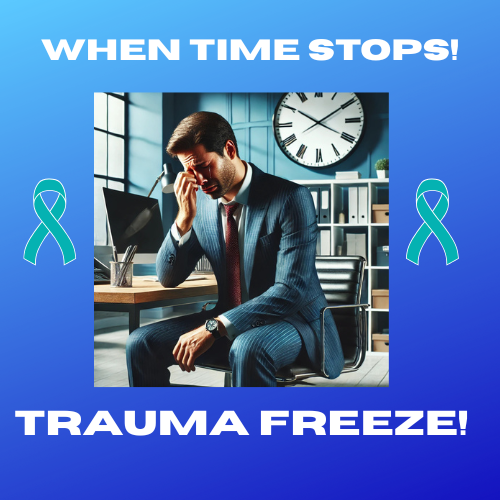The Effects of Bullying and Verbal and Physical Abuse.
The Invisible Chains That Bind Us
Small and defenseless, a child's body is learning to bear the impact of words that penetrate deeper than any blade. Fists leave marks not only on the skin but also on the very architecture of a developing nervous system and the brain. The brain is where trauma begins, not as memory, but as a blueprint etched into every cell, every breath, every heartbeat.
How does someone with PTSD deal with the rage and anger that has become the unwelcome inheritance of abuse?
If you've found yourself asking this question, you're not alone. You're also closer to freedom than you realize.
When the Body Becomes a Battlefield
I lived with this question for decades. School hallways became gauntlets where cruel laughter followed me like shadows. At home, the sound of my father's footsteps meant another night of terror was beginning. The smell of alcohol on his breath, the crack of his hand against my face, and the way my mother would look away, these weren't just experiences. They became the language my body learned to speak.
The rage that grew inside me wasn't just an emotion; it was a consuming force.
The rage, a living entity, found its home in my chest, coiled in my shoulders, and clenched in my fists; when school bullies pushed too far, primal instincts would take control.
The violence I'd absorbed at home found its way out through my hands, my voice, and my very presence, transformed into the very thing I despised, and the system took notice.
They called it "channeling my aggression constructively" when they sent me to the military. What they did was give official sanction to the war already raging inside me.
I learned to aim that fury at enemies of the state, but the real enemy, the trauma living in my bones, came with me to every battlefield.
The Science of Stored Pain
Here's what they don't tell you about trauma: your body remembers everything, even when your mind tries to forget.
Trauma doesn't just live in your thoughts. It embeds itself in your fascia, the connective tissue that wraps around every muscle fiber. It alters the rhythm of your heart, the depth of your breathing, and the way your gut processes food.
Your liver, the organ that processes toxins, becomes overwhelmed trying to filter the chemical storm of chronic stress hormones. Your nervous system made quick decisions about survival when you were in danger.
It decided that hypervigilance was safer than peace. It chose tension over relaxation. It selected anger over vulnerability because fear felt like armor.
Your muscles learned to hold these defensive patterns. Your organs learned to function in crisis mode. Your brain rewired itself around the assumption that danger was always lurking around the corner.
The nightmares, the sleepless nights, the way your body jumps at unexpected sounds—these aren't signs of weakness. They're signs of a system that's been running on emergency power for so long, it's forgotten how to rest.
The Healing from Abuse Manifesto: Six Steps to Reclaim Your Life
Step 1: Acknowledge the Warrior Within
Your survival instincts saved your life. The rage you carry isn't evil; it’s misdirected protection. Begin by honoring the part of you that refused to be destroyed, even as you prepare to teach it new ways to keep you safe.
Practice: Place your hand on your heart and say, "Thank you for keeping me alive. Now I'm going to teach you how to help me thrive."
Step 2: Breathe Your Body Back to Life
Trauma lives in shallow breathing and holding breath. Deep, conscious breathing is your first act of rebellion against the tyranny of stored pain.
Practice: Four counts in, hold for four, out for six. Do this while placing one hand on your chest and one on your belly. Feel what it is like to remember safety.
Step 3: Release the Grip of Muscle Memory
Your muscles have been storing trauma like a vault. You can start unlocking these physical prisons through targeted movement, massage, and conscious relaxation.
Practice: Progressive muscle relaxation, tense each muscle group for five seconds, then release. Start with your toes and work up to your head. Feel the contrast between tension and release.
Step 4: Nourish Your Overwhelmed Organs
Your liver, kidneys, and gut have been working overtime to process the biochemical aftermath of trauma. They need intentional support to heal.
Practice: Drink water like it’s medicine. Eat foods that support liver function, like leafy greens, beets, and turmeric. Give your digestive system rest with gentle, whole foods.
Step 5: Rewire Your Mind's Default Settings
Your brain carved neural pathways based on survival, not thriving. Through mindfulness and conscious choice, you can rewire these patterns.
Practice: When you notice the familiar surge of rage or fear, pause. Ask yourself, "Is this response protecting me from real danger right now, or is it protecting me from ghosts?" Choose your response consciously.
Step 6: Create New Stories in Your Body
To demonstrate that the world can provide safety, your nervous system requires fresh experiences. Seek out experiences of genuine connection, physical safety, and emotional validation.
Practice: Engage in activities that bring your nervous system into "rest and digest" mode: gentle music, warm baths, safe physical touch, and time in nature. Let your body learn what peace feels like.
The Kryptonite to Your PTSD
Here's the truth that no one tells you: The very sensitivity that makes you vulnerable to trauma also makes you capable of profound healing. Your nervous system's ability to absorb pain is matched only by its capacity to absorb love, safety, and peace.
You are not broken. You are not beyond repair. You are a human being whose system learned to survive in impossible circumstances, and now you're learning to thrive in possible ones.
The path forward isn't about forgetting what happened or pretending it didn't matter. It's about teaching your body and mind that the war is over. It's about becoming the gentle, consistent presence that your younger self needed.
Your trauma tried to convince you that you were powerless. Your healing will prove that you are anything but.
The rage that once consumed you can become the fuel for your transformation. The hypervigilance that exhausted you can become discernment. The armor you wore can become the wisdom you share.
You have survived 100% of your worst days. Now it's time to do more than survive.
It's time to come home to yourself.
If you're ready to begin this journey of healing, remember you don't have to do it alone.
Seek out trauma-informed therapists, support groups, and healing modalities that resonate with your experience. Your courage to face your pain is the first step toward freedom.
2025©. www.soundthetrumpet.org









